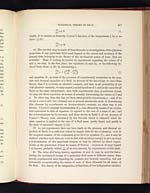Lord Kelvin (1824-1907)
On the dynamical theory of heat. Part 5. On the quantities of mechanical energy contained in a fluid in different states, as to temperature and density
DYNAMICAL THEORY OF HEAT.
477
[NLS note: a graphic appears here – see image of page]
Lastly, if we denote, as formerly, CARNOT’S function of the temperature t, by μ we
have ( § 21)
[NLS note: a graphic appears here – see image of page]
86. The use that may he made of these formulæ in investigations of the physical
properties of any particular fluid must depend on the extent and accuracy of the
general data belonging to the theory of the mechanical action of heat, that are
available. Thus, if nothing be known by experiment regarding the values of J
and μ, we may, in the first place, use equations (4) and (5), or the following de-
duced from them ( § 20) by eliminating e,
[NLS note: a graphic appears here – see image of page]
and equation (6), as tests of the accuracy of experimental researches on the pres-
sure and thermal capacities of a fluid, on account of the knowledge we have from
theory, that J is certainly an absolute constant, and that, in all probability if not
with absolute certainty, we may regard μ as independent of v, and as the same for all
fluids at the same temperature; and, with experimental data of sufficient extent,
we may use these equations as means of actually determining the values of J and
μ. No other way than this has yet been attempted for determining μ; and, if we
except a conceivable but certainly not at present practicable mode of determining
this element by experiments on thermo-electric currents, no other way is yet
known. CARNOT’S original determination of μ, was effected by means of an expres-
sion equivalent to that of equation (6) applied to the case of a mass of air; and
the determinations by CLAPEYRON, and those shewn in Table I. of my Account of
CARNOT’S Theory, were calculated by the formula which is obtained when the
same equation is applied to the case of a fluid mass, partly liquid and partly in
the state of saturated vapour (§ 55).
87. As yet experiments have not been made on the pressure and thermal ca-
pacities of fluids to a sufficient extent to supply data for the evaluation, even in
the roughest manner, of the expression given for J by equation (7); and it may be
doubted whether such data can even be had with accuracy enough to give as exact
a determination of this important element as may be effected by direct experi-
ments on the generation of heat by means of friction. At present we may regard
J as known, probably within 1/300 of its own amount, by experiments of this kind.
88. The value of J being known, equations (4) and (5) may be used for deter-
mining the mechanical energy of a particular fluid mass in different states, from
special experimental data regarding its pressure and thermal capacities, but not
necessarily comprehending the values of each of these elements for all states of
the fluid. The theory of the integration of functions of two independent variables


